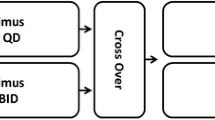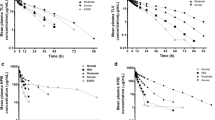Abstract
Objective: ABT-578, a tetrazole analogue of sirolimus (rapamycin), possesses anti-restenosis activity. The aim of this study was to assess the safety and pharmacokinetics of escalating single intravenous (IV) doses of ABT-578 in a phase 1, double-blind, randomised, placebo-controlled study.
Methods: Sixty adult healthy males were divided into five IV-dose groups of 100, 300, 500, 700 and 900μg. Doses were administered as IV bolus over 3 minutes, with eight subjects and four subjects receiving ABT-578 and placebo, respectively, in each dose group. Higher doses were administered after evaluating safety from the preceding lower doses. Blood concentrations of ABT-578 were sampled for 168 hours and measured using LC-MS/MS with a limit of quantification of 0.20 ng/mL.
Results: The pharmacokinetics of ABT-578 were essentially linear across the 100–900μg dose range as illustrated by the dose-proportional increases in concentration at 5 minutes (C5) after the end of infusion and area under the concentration-time curve (AUC). The mean half-life ranged between 26.0 and 40.2h over the studied doses and was not significantly different over the 300–900μg dose range. The mean clearance values ranged from 2.90 to 3.55 L/h. Single IV bolus doses up to 900μg of ABT-578 were well tolerated and no clinically significant changes in physical examination results, vital signs or laboratory test results were observed.
Conclusion: It can be concluded that the pharmacokinetics of IV ABT-578 are dose-proportional over the 100-900μg dose range. Single IV bolus doses up to 900μg were well tolerated in healthy male subjects.






Similar content being viewed by others
Notes
The use of trade names is for product identification purposes only and does not imply endorsement.
References
Ajani AE, Kim HS, Waksman R. Clinical trials of vascular brachytherapy for in-stent restenosis: update. Cardiovasc Radiat Med 2001; 2(2): 107–13
Herzum M, Schaefer JR, Simon B, et al. Restenosis after percutaneous coronary interventions and infection. Herz 2000; 25(2): 91–4
Serruys PW, deJaegere P, Kiemeneij F, et al. A comparison of balloon-expandable-stent implantation with balloon angioplasty in patients with coronary artery disease. Benestent Study Group. N Engl J Med 1994; 331(8): 489–95
Erbel R, Haude M, Hopp HW, et al. Coronary-artery stenting compared with balloon angioplasty for restenosis after initial balloon angioplasty. Restenosis Stent Study Group. N Engl J Med 1998; 339(23): 1672–8
Mintz GS, Hoffmann R, Mehran R, et al. In-stent restenosis: the Washington Hospital Center experience. Am J Cardiol 1998; 81(7A): 7E–13E
Groth CG, Backman L, Morales JM, et al. Sirolimus (rapamycin)-based therapy in human renal transplantation: similar efficacy and different toxicity compared with cyclosporine. Sirolimus European Renal Transplant Study Group. Transplantation 1999; 67(7): 1036–42
Casterella PJ, Teirstein PS. Prevention of coronary restenosis. Cardiol Rev 1999; 7(4): 219–31
Sousa JE, Costa MA, Abizaid A, et al. Lack of neointimal proliferation after implantation of sirolimus-coated stents in human coronary arteries: a quantitative coronary angiography and three-dimensional intravascular ultrasound study. Circulation 2001; 103(2): 192–5
Sousa JE, Costa MA, Abizaid AC, et al. Sustained suppression of neointimal proliferation by sirolimus-eluting stents: one-year angiographic and intravascular ultrasound follow-up. Circulation 2001; 104(17): 2007–11
Sousa JE, Costa MA, Sousa AG, et al. Two-year angiographic and intravascular ultrasound follow-up after implantation of sirolimus-eluting stents in human coronary arteries. Circulation 2003; 107(3): 381–3
Brattstrom C, Sawe J, Jansson B, et al. Pharmacokinetics and safety of single oral doses of sirolimus (rapamycin) in healthy male volunteers. Ther Drug Monit 2000; 22(5): 537–44
Yatscoff RW. Pharmacokinetics of rapamycin. Transplant Proc 1996; 28(2): 970–3
Gallant-Haidner HL, Trepanier DJ, Freitag DG, et al. Pharmacokinetics and metabolism of sirolimus. Ther Drug Monit 2000; 22(1): 31–5
Schwartz RS, Burke SE, Cromack K, et al. Marked neointimal inhibition from a drug eluting stent: effects of local ABT-578 in the porcine coronary model [abstract]. Circulation 2002; 106Suppl. II: 448
Buellesfeld L, Grube E. ABT-578-eluting stents: the promising successor of sirolimus- and paclitaxel-eluting stent concepts? Herz 2004; 29(2): 167–70
Salu KJ, Bosmans JM, Bult H, et al. Drug-eluting stents: a new treatment in the prevention of restenosis. Part I: experimental studies. Acta Cardiol 2004; 59(1): 51–61
Salu KJ, Bosmans JM, Bult H, et al. Drug-eluting stents: a new treatment in the prevention of restenosis. Part II: clinical studies. Acta Cardiol 2004; 59(2): 165–77
Ji QC, Todd Reimer M, El-Shourbagy TA. 96-well liquid-liquid extraction liquid chromatography-tandem mass spectrometry method for the quantitative determination of ABT-578 in human blood samples. J Chromatogr B Analyt Technol Biomed Life Sci 2004; 805(1): 67–75
Zimmerman JJ, Kahan BD. Pharmacokinetics of sirolimus in stable renal transplant patients after multiple oral dose administration. J Clin Pharmacol 1997; 37(5): 405–15
Kahan BD. Update on pharmacokinetic/pharmacodynamic studies with FTY720 and sirolimus. Ther Drug Monit 2002; 24(1): 47–52
Acknowledgements
This work was funded by Abbott Laboratories, Abbott Park, Illinois, USA. The authors were all employees of Abbott during the preparation of this article.
Author information
Authors and Affiliations
Corresponding author
Rights and permissions
About this article
Cite this article
Palaparthy, R., Pradhan, R., Chan, J. et al. Pharmacokinetics and Safety of ABT-578, a Sirolimus (Rapamycin) Analogue, after Single Intravenous Bolus Injection in Healthy Male Volunteers. Clin. Drug Investig. 25, 491–498 (2005). https://doi.org/10.2165/00044011-200525080-00001
Published:
Issue Date:
DOI: https://doi.org/10.2165/00044011-200525080-00001




